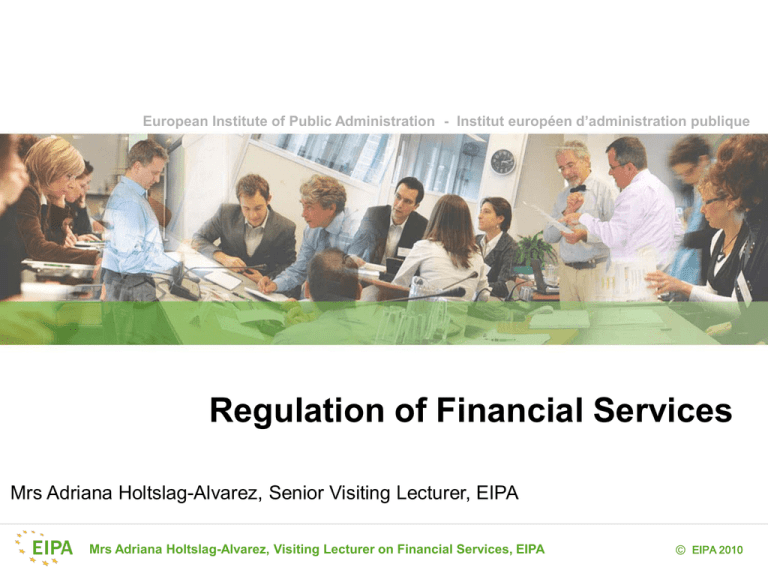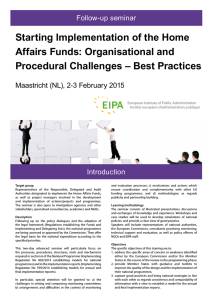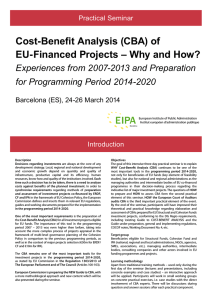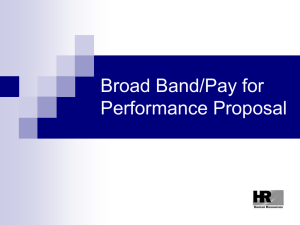PowerPoint Template - 7th Annual International Regulatory Affairs
advertisement

European Institute of Public Administration - Institut européen d’administration publique Regulation of Financial Services Mrs Adriana Holtslag-Alvarez, Senior Visiting Lecturer, EIPA Mrs Adriana Holtslag-Alvarez, Visiting Lecturer on Financial Services, EIPA © EIPA 2010 Benefits , Dangers, Contradictions and Failures International Centre for Parliamentary Studies 4th Annual Regulatory Affairs Symposium 2012 Tuesday 27th and Wednesday 28th March 2012 “Being an Effective Regulator in Challenging Times” © EIPA 2010 - WWW.EIPA.EU Case Study: Financial Services What is the role of financial services firms? Such as : Banks, insurance, securities and hybrid firms Intermediation crucial to the economy How to define the quality of capital? Causes of the financial crisis? © EIPA 2010 - WWW.EIPA.EU Case Study: Financial Services Why regulate? What to regulate? By whom? Who will apply new rules? And who will comply? And check compliance? Role of Supervisors Role of EU Role of national authorities of 27 Member States © EIPA 2010 - WWW.EIPA.EU Global regulation Financial services uniquely cross border 2008/2009 Financial crisis Search for solutions What went wrong so what needs to be fixed? Who will do what? Define goals Delineate topics and issues © EIPA 2010 - WWW.EIPA.EU When the sub-prime crisis struck Years of downturn: loss of investors’ confidence Blockage of credit markets: liquidity more like an arid desert Stock markets spiral up and down: what are the economics of this? Banks are in the docket: fair to accuse them alone? Lack of cooperation of supervisors blamed Lack of effective transatlantic cooperation Knee jerk reactions all round. © EIPA 2010 - WWW.EIPA.EU 6 Crisis : the Commission stated We can no longer rely on wholesale financial markets to look after their own long-term interests. We can no longer rely on empty assertions that if nothing has gone wrong so far in a particular sector as evidence that nothing will. Sub-prime has taught us that. We can no longer rely on outmoded notions of national regulation and supervision. We made rapid assessments of Member State bank rescue schemes. Or: State aid allowed. © EIPA 2010 - WWW.EIPA.EU Plethora of responses EU : European Commission Council of Ministers and European Parliament ECB Basel: BCBS – Basel norms for capital ratios FSB = Financial Stability Board United States – Dodd Frank Bilateral and Multilateral = G 3, 4, 5, 6, 7 ... G20 IMF and World Bank Multilateral response : difficult to channel © EIPA 2010 - WWW.EIPA.EU Europe = European Union = Single Market Single market requires Single rule book? Consistency with global reforms? Effectiveness and fairness of new regulatory framework? © EIPA 2010 - WWW.EIPA.EU Single Market: (main) goal of the European Union Four freedoms: goods, services, establishment, capital Single market was doing well in the 90’s Just not for financial services Lack of capital movements ECJ was doing its part in liberalising market RATIO for new regulation: Need to create single market for financial services: wholesale and retail FSAP: Financial Services Action Plan was born end of the 90’s © EIPA 2010 - WWW.EIPA.EU Building Blocks of the Single Market for Financial Services: Home country control in supervision (= supervision by authorities of MS of origin) Mutual recognition of equivalence: the EU passport Minimum Harmonisation of key regulatory protections Co-ordination between host and home State authorities (no single / central enforcement agencies © EIPA 2010 - WWW.EIPA.EU What Single Market? Do all 27 EU Member States have the same objectives? Not all regulators – their goal is to reduce risk Not all supervisors – nationally oriented (home country control !!) Not all Member States – protectionist tendencies Not all market players – each large firm has own carve outs and niches…. © EIPA 2010 - WWW.EIPA.EU White Paper of Dec. 2005 Set out the Financial Services Policy for 2005 – 2010 An internal market is a properly integrated market: efficient and competitive OBJECTIVES: To achieve high degree of integration Consolidate what had been done Remove remaining barriers Implement, enforce, evaluate existing legislation Enhance supervisory cooperation and convergence… © EIPA 2010 - WWW.EIPA.EU 13 BETTER REGULATION The Commission followed a “better regulation” approach thorough impact assessment extensive consultation © EIPA 2010 - WWW.EIPA.EU BETTER REGULATION Extensive revision of financial services sectoral legislation: - Traditional EU rule making - Lamfalussy Procedure - New levels of “technical” input - New ESA’s © EIPA 2010 - WWW.EIPA.EU The Lamfalussy structure: Council Commission Parliament L1 Legislation EBC¹ EIOPC¹ ESC¹ FCC¹ L2 Implementing details CEBS² CEIOPS³ CESR³ L3 Convergence L4 Enforcement Commission EBC = European Banking Committee EIOPC = European Insurance and Occupational Pensions Committee ESC = European Securities Committee FCC = Financial Conglomerates Committee CEIOPS = Committee of European Insurance and Occupational Pensions Supervisors CESR = Committee of European Securities Regulators ¹ Finance ministries ² Supervisors and Central Banks ³ Supervisors © EIPA 2010 - WWW.EIPA.EU New Powers - Additional technical powers: - Draft technical standards – work towards common rulebook - Exchange of information and settle disputes - So: Co-ordinated approach © EIPA 2010 - WWW.EIPA.EU The new EU supervisory architecture Two independent and complementary pillars: European Systemic Risk Board (ESRB)- macroprudential supervision European System of Financial Supervisors (ESFS)micro-prudential supervision ESFS: Level 3 Committees (CEBS, CESR, CEIOPS) are now: European Supervisory Authorities (ESAs), namely the EBA, ESMA and EIOPA Cross-sectoral co-operation via the Joint Committee © EIPA 2010 - WWW.EIPA.EU Common European Rulebook The new authorities’ role: - Developing technical standards - Interpretative guidelines so national authorities can take a decision However: Technical standards become binding law after endorsement by the European Commission © EIPA 2010 - WWW.EIPA.EU EBA Regulatory Tasks Common rulebook Maximum harmonisation ...but proportionate to different financial institutions EU Commission Sectoral Directives EBA ‘Implementing legislation’ EBA provide advice EBA issuing guidelines and recommendations (as before) Developing draft binding technical standards © EIPA 2010 - WWW.EIPA.EU 20 20 20 ESFS and ESAs - 3 independent Authorities working together in a network of supervisors NSA NSA EBA NSA NSA NSA Joint Committee NSA EIOPA ESMA NSA NSA NSA © EIPA 2010 - WWW.EIPA.EU G20 Commitments : Progress table What areas are covered? And also by FSB….. Capital Framework (New CRD4) implements Basel III Accounting standards Remuneration and compensation Management of counterparty risk Insurance (overall issues): Solvency II Derivatives (Mifid review, MAD review, transparency and clearing issues) SIFIs: European Crisis Resolution Framework © EIPA 2010 - WWW.EIPA.EU G20 Commitments : Progress table What areas are covered? Strengthening Corporate Governance Consumer’s interests: how to educate them? Deposit Insurance – new proposal Credit Rating Agencies (CRAs) Hedge Funds and private equity As well as the regulatory and supervisory system: European Systemic Risk Council and European System of Financial Supervisors. © EIPA 2010 - WWW.EIPA.EU What new theme to address? Recent consultation on Shadow Banking These are poorly or non regulated entities/activities MMF – money market funds, Securitisation, Securities lending, hedge funds, etc Represent 25-30% of the world’s financial sector = 46 Trillion Euros Posing very high risks such as runs due to short term funding, build up of high hidden leverage, credit bubbles, and possible contagion into the “regulated” sector Most probably: circumvention of rules and regulatory arbitrage © EIPA 2010 - WWW.EIPA.EU and where are we heading? Fiercer competition More sophisticated consumers Increased regulation at global level BUT for sure: at least part of the financial services industry will take on a new shape © EIPA 2010 - WWW.EIPA.EU Challenges and Trends Shift away from principles based regulation Back to rules based framework regulation Regulators must cooperate globally Consolidation process: in-country or cross-border Regulation creates level playing field (does it?) Helping consumers by teaching financial literacy © EIPA 2010 - WWW.EIPA.EU Challenges and Trends The costs of compliance: price tag for financial firms Corporate Governance catalyst: focus on risk management - and concern of a more “aggressive regulator” , hands on strategy to supervision….. CSR and increasing environmental awareness (the crisis did not make these go away!) More need of long term thinking: ethical investments as part of risk management © EIPA 2010 - WWW.EIPA.EU - Zen Buddhism and the Art of Financial Regulation - How to meditate while you regulate - Or: how to regulate while you meditate Alternatively: what can be done to prevent this from happening again? © EIPA 2010 - WWW.EIPA.EU Conclusions (or more questions) All current efforts are carefully scrutinized by banks Unity of purpose is not evident: EU- US divide Complex market, complex products: simplification? Back to core banking? F.i.’s should provide products people can trust Thus: restore trust in banking and financial services New views on moral hazard and role of public sector Risk of future crisis: cannot regulate for the unknown © EIPA 2010 - WWW.EIPA.EU So where are the future weaknesses? What and where is the unknown ? Where is the next financial crisis? Why is implementation such a problem? Are the regulators and supervisors staffed adequately? Is there sufficient funding? Who can pay the best lobbyists? What and whose interests are being represented? Issue of transparency: produce the data that allows the regulator to really compare relative risk and see the real weaknesses. © EIPA 2010 - WWW.EIPA.EU Discussion time © EIPA 2010 - WWW.EIPA.EU








